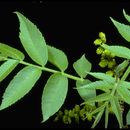pt-BR
nomes no trilho de navegação


Juglans major (Arizona-Schwarznuss[1]) ist eine nordamerikanische Baumart der Gattung Walnüsse (Juglans).
Juglans major ist ein 5 bis 18 m hoher Baum und bildet manchmal mehrere Stämme. Die Borke ist hell- bis mittelgrau und schachbrettartig in kleine Platten unterteilt. Das Mark der Zweige ist braun. Die endständigen Knospen sind schmal eiförmig oder kegelförmig, abgeflacht und 4 bis 7 mm lang.
Die Blätter sind 18 bis 38 cm lang, der Blattstiel 3 bis 6 cm. Die 9 bis 15 Fiederblättchen sind lanzeolat bis lanzeolat-eiförmig, symmetrisch oder sichelförmig, 6,5 bis 10,5 cm lang und 1,5 bis 3,4 cm breit. Der Blattrand ist gesägt, die Blattspitze schmal zugespitzt. Die Blattunterseite ist mit kopfig-drüsigen Haaren, mit einfachen oder zwei- bis vierstrahligen Büschelhaaren und oft auch mit verstreuten Schuppen besetzt. In den Nervenachseln stehen häufig Haarbüschel. Auf der Blattoberseite sitzen kopfig-drüsige Haare, manchmal zerstreut Büschelhaare, die Oberseite verkahlt später. Das endständige Blättchen ist meist klein oder fehlt ganz.
Die männlichen Kätzchen sind 5 bis 8 cm lang. Jede Blüte besitzt 20 bis 40 Staubblätter. Die Pollensäcke sind 1,2 bis 1,4 mm lang.
Pro Fruchtstand werden ein bis drei Früchte gebildet, die annähernd kugelig oder kurz eiförmig sind und 2 bis 3,5 cm groß. Die Oberfläche ist glatt und dicht mit kopfig-drüsigen Haaren und schildförmigen Schuppen besetzt. Die Nüsse sind kugelig bis eiförmig, 1,8 bis 2,7 cm groß, tief längs gefurcht. Die Oberfläche zwischen den Furchen ist glatt.
Die Chromosomenzahl beträgt 2n = 32.[2]
Juglans major ist im Süden der USA und in Mexiko beheimatet. Die Bäume wachsen an Flüssen und an felsigen Schluchtstandorten in 300 bis 2100 m Seehöhe.
Juglans major wird innerhalb der Gattung Juglans in die Sektion Rhysocaryon gestellt. Sie ist eng mit Juglans nigra und Juglans microcarpa verwandt.[3]
Innerhalb der Art werden zwei Varietäten unterschieden:
Juglans major (Arizona-Schwarznuss) ist eine nordamerikanische Baumart der Gattung Walnüsse (Juglans).
Juglans major (literally, the larger walnut), also known as Arizona walnut,[1] is a walnut tree which grows to 50 ft tall (15 m) with a DBH of up to 0.61 metres (2 ft) at elevations of 300–2,130 m (1,000–7,000 ft) in Texas, Oklahoma, New Mexico, Arizona, and Utah.[4] It also occurs in Mexico as far south as Guerrero.[5] Common names include Arizona black walnut (as it belongs to the "black walnuts" section Juglans sect. Rhysocaryon), and the Spanish name nogal cimarrón (cimarron walnut).
In moister areas, the tree features a single, stout trunk; there are usually several slender trunks in drier situations.[6] The 8–14 in long pinnately compound leaves bear 9–15 lanceolate leaflets, 19–32 mm (.75–1.25 in) wide by 51–102 mm (2–4 in) long. The small nut has a thick shell with deep grooves enclosing an oily, edible seed.[7][8]
Where the range of J. major overlaps that of J. microcarpa, the two interbreed, producing many intermediate forms.[9][10]
Juglans major (literally, the larger walnut), also known as Arizona walnut, is a walnut tree which grows to 50 ft tall (15 m) with a DBH of up to 0.61 metres (2 ft) at elevations of 300–2,130 m (1,000–7,000 ft) in Texas, Oklahoma, New Mexico, Arizona, and Utah. It also occurs in Mexico as far south as Guerrero. Common names include Arizona black walnut (as it belongs to the "black walnuts" section Juglans sect. Rhysocaryon), and the Spanish name nogal cimarrón (cimarron walnut).
Le Noyer noir d'Arizona (Juglans major) est une espèce de noyer originaire du Mexique et du sud-ouest des États-Unis.
Ce noyer est présent dans certaines régions du Mexique et dans les États américains du Texas, de l'Oklahoma, du Nouveau-Mexique, de l'Arizona et de l'Utah à des altitudes comprises entre 300 et 2 100 mètres[2].
L'arbre monoïque atteint en général une taille de quinze mètres[3] pour un tronc de soixante centimètres. La feuille qui peut atteindre une trentaine de centimètres est composée de neuf à quinze folioles[4]. La noix de forme ronde (2 à 3 cm de diamètre) a une épaisse coquille avec des rainures profondes qui renferme un cerneau comestible gras[4].
Ce noyer peut s'hybrider avec Juglans microcarpa[5],[6].
En plus de la récolte de ses noix pour la consommation, le bois de l'arbre peut être utilisé dans la menuiserie ou comme bois de chauffage[3].
Le Noyer noir d'Arizona (Juglans major) est une espèce de noyer originaire du Mexique et du sud-ouest des États-Unis.
Juglans major là một loài thực vật có hoa trong họ Juglandaceae. Loài này được (Torr.) A. Heller mô tả khoa học đầu tiên năm 1904.[3]
Juglans major là một loài thực vật có hoa trong họ Juglandaceae. Loài này được (Torr.) A. Heller mô tả khoa học đầu tiên năm 1904.